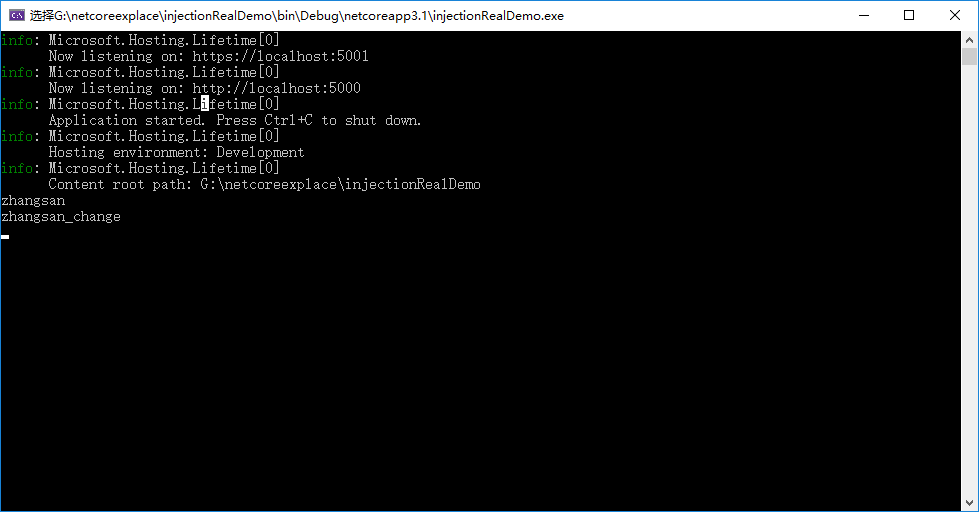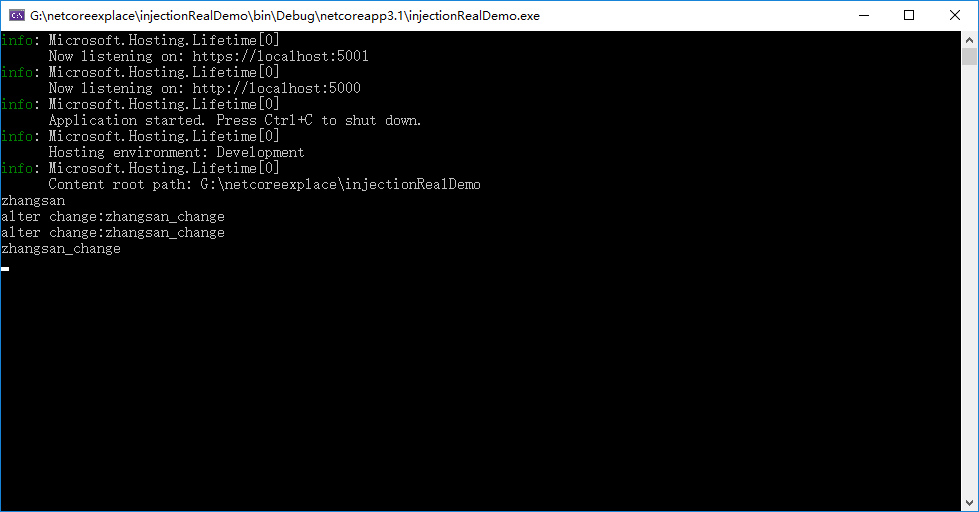重新整理 .net core 实践篇—————服务的配置更新[十三]
前言
前文讲述了,服务和配置直接的配合,这一节写一下,当配置文件修改了,每个服务如何感知自己的配置。
正文
服务感知到自己的配置发生变化,这就牵扯出两个东西:
IoptionsMonitor<out TOptions>
IoptionSnapshot<out TOptions>
在作用域范围使用IoptionSnapshot,在单例中使用IoptionsMonitor 。
IoptionsMonitor
先来演示作用域范围的使用。
配置:
{
"SelfService": {
"name" : "zhangsan"
}
}
SelfServiceOption:
public class SelfServiceOption
{
public string Name { get; set; }
}
服务:
public class SelfService : ISelfService
{
IOptionsSnapshot<SelfServiceOption> _options;
public SelfService(IOptionsSnapshot<SelfServiceOption> options)
{
this._options = options;
}
public string ShowOptionName()
{
return _options.Value.Name;
}
}
注册:
services.Configure<SelfServiceOption>(Configuration.GetSection("SelfService"), BinderOptions =>
{
BinderOptions.BindNonPublicProperties = true;
});
services.AddScoped<ISelfService, SelfService>();
测试:
[HttpGet]
public int GetService([FromServices]ISelfService selfService)
{
Console.WriteLine(selfService.ShowOptionName());
return 1;
}
结果:

第一次访问后修改为zhangsan_change,再次访问接口,会呈现上述效果。
那么为什么使用IoptionsMonitor,而为什么Ioptions 没有用呢。
前一篇写过Ioptions 的实现类OptionsManager,这个是有缓存的_cache,如下:
public class OptionsManager<TOptions> : IOptions<TOptions>, IOptionsSnapshot<TOptions> where TOptions : class, new()
{
private readonly IOptionsFactory<TOptions> _factory;
private readonly OptionsCache<TOptions> _cache = new OptionsCache<TOptions>(); // Note: this is a private cache
/// <summary>
/// Initializes a new instance with the specified options configurations.
/// </summary>
/// <param name="factory">The factory to use to create options.</param>
public OptionsManager(IOptionsFactory<TOptions> factory)
{
_factory = factory;
}
/// <summary>
/// The default configured <typeparamref name="TOptions"/> instance, equivalent to Get(Options.DefaultName).
/// </summary>
public TOptions Value
{
get
{
return Get(Options.DefaultName);
}
}
/// <summary>
/// Returns a configured <typeparamref name="TOptions"/> instance with the given <paramref name="name"/>.
/// </summary>
public virtual TOptions Get(string name)
{
name = name ?? Options.DefaultName;
// Store the options in our instance cache
return _cache.GetOrAdd(name, () => _factory.Create(name));
}
}
IoptionsMonitor的实现类也是OptionsManager,但是人家是作用域模式。
在Addoptions中:
services.TryAdd(ServiceDescriptor.Singleton(typeof(IOptions<>), typeof(OptionsManager<>)));
services.TryAdd(ServiceDescriptor.Scoped(typeof(IOptionsSnapshot<>), typeof(OptionsManager<>)));
也就是说每创建一个SelfService,就会创建一个OptionsManager。缓存自然只在作用域内有效。
好的,那么来看下单例。
IoptionsMonitor
服务:
public class SelfService : ISelfService
{
IOptionsMonitor<SelfServiceOption> _options;
public SelfService(IOptionsMonitor<SelfServiceOption> options)
{
this._options = options;
_options.OnChange((selftServiceOptions) =>
{
Console.WriteLine("alter change:"+selftServiceOptions.Name);
});
}
public string ShowOptionName()
{
return _options.CurrentValue.Name;
}
}
注册:
services.Configure<SelfServiceOption>(Configuration.GetSection("SelfService"), BinderOptions =>
{
BinderOptions.BindNonPublicProperties = true;
});
services.AddSingleton<ISelfService, SelfService>();
测试接口:
[HttpGet]
public int GetService([FromServices]ISelfService selfService)
{
Console.WriteLine(selfService.ShowOptionName());
return 1;
}
同意是修改钱访问一次,修改后访问一次。
结果如下:

那么看下IOptionMonitor的实现类OptionsMonitor:
public class OptionsMonitor<TOptions> : IOptionsMonitor<TOptions>, IDisposable where TOptions : class, new()
{
private readonly IOptionsMonitorCache<TOptions> _cache;
private readonly IOptionsFactory<TOptions> _factory;
private readonly IEnumerable<IOptionsChangeTokenSource<TOptions>> _sources;
private readonly List<IDisposable> _registrations = new List<IDisposable>();
internal event Action<TOptions, string> _onChange;
/// <summary>
/// Constructor.
/// </summary>
/// <param name="factory">The factory to use to create options.</param>
/// <param name="sources">The sources used to listen for changes to the options instance.</param>
/// <param name="cache">The cache used to store options.</param>
public OptionsMonitor(IOptionsFactory<TOptions> factory, IEnumerable<IOptionsChangeTokenSource<TOptions>> sources, IOptionsMonitorCache<TOptions> cache)
{
_factory = factory;
_sources = sources;
_cache = cache;
foreach (var source in _sources)
{
var registration = ChangeToken.OnChange(
() => source.GetChangeToken(),
(name) => InvokeChanged(name),
source.Name);
_registrations.Add(registration);
}
}
private void InvokeChanged(string name)
{
name = name ?? Options.DefaultName;
_cache.TryRemove(name);
var options = Get(name);
if (_onChange != null)
{
_onChange.Invoke(options, name);
}
}
/// <summary>
/// The present value of the options.
/// </summary>
public TOptions CurrentValue
{
get => Get(Options.DefaultName);
}
/// <summary>
/// Returns a configured <typeparamref name="TOptions"/> instance with the given <paramref name="name"/>.
/// </summary>
public virtual TOptions Get(string name)
{
name = name ?? Options.DefaultName;
return _cache.GetOrAdd(name, () => _factory.Create(name));
}
/// <summary>
/// Registers a listener to be called whenever <typeparamref name="TOptions"/> changes.
/// </summary>
/// <param name="listener">The action to be invoked when <typeparamref name="TOptions"/> has changed.</param>
/// <returns>An <see cref="IDisposable"/> which should be disposed to stop listening for changes.</returns>
public IDisposable OnChange(Action<TOptions, string> listener)
{
var disposable = new ChangeTrackerDisposable(this, listener);
_onChange += disposable.OnChange;
return disposable;
}
/// <summary>
/// Removes all change registration subscriptions.
/// </summary>
public void Dispose()
{
// Remove all subscriptions to the change tokens
foreach (var registration in _registrations)
{
registration.Dispose();
}
_registrations.Clear();
}
internal class ChangeTrackerDisposable : IDisposable
{
private readonly Action<TOptions, string> _listener;
private readonly OptionsMonitor<TOptions> _monitor;
public ChangeTrackerDisposable(OptionsMonitor<TOptions> monitor, Action<TOptions, string> listener)
{
_listener = listener;
_monitor = monitor;
}
public void OnChange(TOptions options, string name) => _listener.Invoke(options, name);
public void Dispose() => _monitor._onChange -= OnChange;
}
}
给每个给做了监听哈:
foreach (var source in _sources)
{
var registration = ChangeToken.OnChange(
() => source.GetChangeToken(),
(name) => InvokeChanged(name),
source.Name);
_registrations.Add(registration);
}
这个IOptionsChangeTokenSource怎么来的呢?是在我们的configure配置方法中:
public static IServiceCollection Configure<TOptions>(this IServiceCollection services, string name, IConfiguration config, Action<BinderOptions> configureBinder)
where TOptions : class
{
if (services == null)
{
throw new ArgumentNullException(nameof(services));
}
if (config == null)
{
throw new ArgumentNullException(nameof(config));
}
services.AddOptions();
services.AddSingleton<IOptionsChangeTokenSource<TOptions>>(new ConfigurationChangeTokenSource<TOptions>(name, config));
return services.AddSingleton<IConfigureOptions<TOptions>>(new NamedConfigureFromConfigurationOptions<TOptions>(name, config, configureBinder));
}
看到这一段:services.AddSingleton<IOptionsChangeTokenSource
当有修改后,那么会调用:
private void InvokeChanged(string name)
{
name = name ?? Options.DefaultName;
_cache.TryRemove(name);
var options = Get(name);
if (_onChange != null)
{
_onChange.Invoke(options, name);
}
}
这里面会移除缓存_cache.TryRemove(name);,然后重新新调用: Get(name);也就会再绑定一次。
这里面有一个值得注意的是,如果有回调,不一定是本身这个服务的配置修改,可能是其他服务的配置修改了,也会被通知,因为这个是文件发生变化就会被通知。
原理如下:
GetSession会返回一个 ConfigurationSection。那么它里面的GetReloadToken是这样的:
public IChangeToken GetReloadToken() => _root.GetReloadToken();
这返回了ConfigurationRoot的GetReloadToken。
实验一下:
{
"SelfService": {
"name": "zhangsan"
},
"SelfService2": {
"name" : "good one"
}
}
改成:
{
"SelfService": {
"name": "zhangsan"
},
"SelfService2": {
"name" : "good one1"
}
}
结果:

索引我们可以在服务里面配置增加一个version版本号,如果版本修改了,然后才做相应的操作。
结
以上只是个人整理,如有错误,望请指点。
下一节:配置验证。


